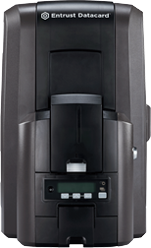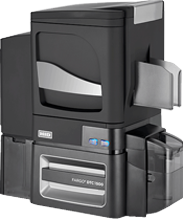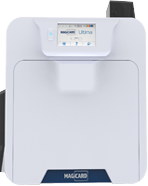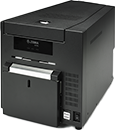ID Card Printers
Choose from a wide range of ID Card Printers from all major brands such as Zebra, Fargo, Magicard, Evolis, Datacard, IDP, and Nisca.
- Large choice of single-sided, duplex, laminating and retransfer ID Card Printers.
- Price match guarantee and free shipping on all orders.
- Toll-free customer support whenever you need help.
- Free consultations to help you find the right printer for your needs.
- Call us today at 1-800-897-7024 for a FREE consultation with an ID expert.
Shop id card printers by brand
Best Sellers
%26NUMONPAGE%3D5%26CAT_TAG%3Did-card-printers%26NEED_COMMENTS%3D0%26DEFAULT_SORTING%3D+a.%60PRICE%60%26ENTIRE_LIST_TEMPLATE%3Dproducts_list_list2020.html%26ITEM_TEMPLATE%3Dproducts_list_item2020.html%26IS_FEATURED%3D1%26COLMD%3D6%26COLLG%3D3The Complete Guide to ID Card Printers
ID card printers are used to make badges and ID cards for a wide variety of applications. The first step in picking the right kind of ID card printer or ID badge maker is to determine your specific requirements. It is important to take into account the different scenarios in which the ID cards will be used so that you can choose a card printer with the features that you need. Take into consideration the following questions when selecting an ID card printer or badge maker.
ID Badges are often used in a security sensitive environment to provide a quick way to verify if the person holding the card belongs in your facility. An identification badge usually includes the person's name, photo, and sometimes even a barcode. A simple ID badge without many features can be fairly inexpensive to print. Badges are often swiped or displayed frequently, so durability and wearability may also be a concern when selecting a badge maker.
There are 2 main types of ID card printers: Direct-to-card printers and retransfer printers.
Direct-to-card printers print the text and images onto the plastic card itself. These printers do not print all the way to the card's edge, and thus leave a small, visible margin around the edge of the card.
A retransferprinter prints all the way to the edge of an ID card, which is called "over the edge"" printing. Retransfer printers work by first printing everything onto to a retransfer film, which is then fused onto the surface of the card. These printers possess another advantage over direct-to-card printing: they can print on cards with uneven surfaces, such as technology cards or pre-punched cards.
Do You Need Information Printed on One Side or Both Sides of the ID Card or Badge?
The first thing to consider is if you can fit everything you need on one side of the ID card. If the answer is yes, go for a single-sided ID card printer. Durable and inexpensive, they are great to print visual IDs with a photo, logo, company name and cardholder data.
If you need to print additional information on your cards, consider a dual-sided ID card printer. Also known as duplex card printers, these machines allow you to print on both sides of your ID card in one pass.
- Student IDs, for example, may have the student's identification information on the front of the card and a school year calendar or the student's schedule printed on the back.
- Membership cards to fitness centers often contain information on both sides of the ID cards. The cards often include contact information and business hours on the back for marketing and convenience purposes.
Do Your ID Cards Need to Be Extra Durable?
If you want to add an extra layer of security to your cards, then you should look into a laminating ID badge maker, which places a clear or custom protective film over the surface of the card. This film protects the printed text and graphics on the card, extending its lifetime. Any situation where an identification card is used repeatedly is probably where you want to use lamination. Lamination would be an ideal solution for the ID badges of doctors and surgeons at a hospital, since they frequently need to swipe their badges in order to access restricted areas like operating rooms.
A laminating ID card printer helps reduce the risk of tampering and counterfeiting especially when choosing custom holograms.
Just as some plastic card printers are able to print on one or both sides of a card, some laminating ID card printers are also able to laminate one or both sides. Choose a printer with single-sided lamination or dual-sided lamination based on the level of security that you need.
What If You Need to Store Information on your cards?
One of the most common reasons for encoding information on a card is access control. Whether it's a simple barcode which allows you into a hotel exercise room, concierge floor or VIP lounge, or a smart card which allows bank employees into a vault, encoding unique numbers onto the badges allows you to control who gets into a secure area. In addition to access control, encoding is often used on loyalty cards. Tying a person's name to a unique number allows for reliable tracking in your database each time they visit your store or make a purchase.
An ID badge maker with an encoder is able to store information on the card at the same time. Encoding is the process of storing information on a card. There are four main ways to encode information on a card: a printed barcode, a magnetic stripe, RFID and a contact smart card.
Adding a barcode to your cards is easy and doesn't require any additional modules in your ID card printer. Barcodes are printed on the card just like any other text or graphics, making barcodes the most affordable encoding option.
A magnetic stripe is a black strip of magnetic material present on some cards which is able to store, read and modify small amounts of information by sliding the stripe through a reader. Go with an ID card printer with a magnetic encoder to add data to your cards and issue access badges.
An ID badge maker with an RFID encoder can make contactless proximity cards, which can be read by simply holding the card near the reader. Keep in mind that proximity cards are read-only—the data (usually a long, unique number) can be retrieved from the card, but not altered.
An ID card printer with a contact smart card encoder produces cards which are read by inserting a chip into a reader. This type of printers is mostly used for banking applications.
Will your card printer be connected to a network?
Card printers come standard with a USB interface to connect your printer to your computer. However, if several computers need to access your card printer, you will need Ethernet connectivity.
Some manufacturers offer USB and Ethernet as standard but some don't, so make sure to select a card printer with Ethernet if needed.
Are There ID Card Printers for Specific Industries?
Here are some suggestions for ID card printers that work well in specific industries.
ID Card Printers for Corporations
For small businesses, a single-sided direct-to-card ID card printer is a good option to print visual IDs easily and affordably. For larger companies, the employee identification cards might have to be integrated with access control systems which usually requires some kind of encoding feature. They might also require a higher level of print quality, making a retransfer ID card printer a very good option.
ID Badge Makers for Educational Institutions
Single-sided and dual-sided ID card printers are a great fit for K-12 schools, since they are an effective and affordable way to secure the campus by allowing quick identification of students, employees, and visitors. Assigning a student a badge with a barcode also allows each student to use the badge to check out books and even pay for meals on campus.
A badge which combines a contact or contactless smart card with a name and photo printed on the front is perfect for university students. They can use their school IDs to access computer labs and pay for food by tying the ID cards to their meal plan. This type of applications requires an ID card printer with a smart card encoder.
ID Card Printers for the Healthcare Industry
The healthcare industry relies on secure IDs to ensure everyone's safety while still allowing the smooth flow of people throughout the facility. Dual-sided ID card printers are widely used to issue ID badges that display the person's name, department, title, and picture.
Healthcare facilities are moving in the direction of laminated badges. Therefore, a card printer with a lamination module is also a great choice.
Government ID Badge Makers
Government IDs often require a very high level of security that a simple ID badge maker cannot provide. Protecting the information in drivers' licenses, government agency badges, and national identification cards is vital to maintaining high security standards and ensuring that the right people are accessing secure government areas and services.
To meet these needs, government ID cards should be laminated with holographic overlays (often with custom holograms for added security) and encoded with secure data. Also, the ID card printer you choose should feature additional security safeguards that prevent the printers from being used without authorization, such as password protection.
ID Card Printers for Access to Events
ID card printers for events such as concerts, conventions, and conferences commonly need to make badges which control access to the venue, while allowing the smooth flow of attendees, visitors, VIPs, and staff. These two requirements can be met by contactless proximity cards, a smart choice for large or high-profile events.
For small industry conferences, where the volume of people is not as high, barcodes and magnetic stripes on badges, together with the person's name and photo, can provide the security of access control at an affordable cost. Regardless of the size of the event, quick card printing is essential for reducing lines at the registration desk.
Transportation Industry ID Card Printers
In the transportation industry, many employee badges use a smart card or magnetic stripe for access control. Customer travel passes commonly use magnetic stripes, which deduct from the passenger's balance every time the pass is swiped during boarding.
Many larger transportation systems have moved to contactless smart cards. These cards can store a large amount of information in a much more secure way, and they are easier to use, allowing people to board quicker. Use an ID badge maker with a smart card encoder to issue these cards.









 Magicard Printers
Magicard Printers
 Zebra Printers
Zebra Printers
 Entrust Datacard
Entrust Datacard
 Nisca Printers
Nisca Printers
 IDP Printers
IDP Printers
 Canon/SwiftColor Printers
Canon/SwiftColor Printers
 Matica Printers
Matica Printers



